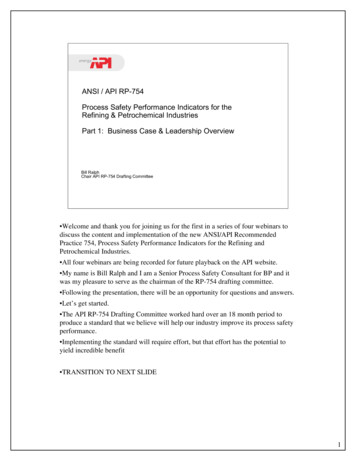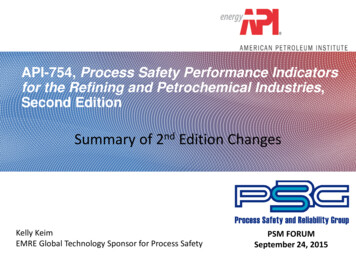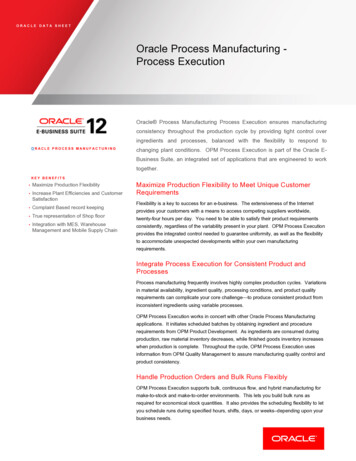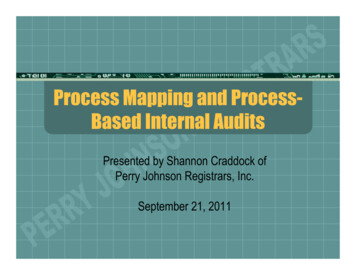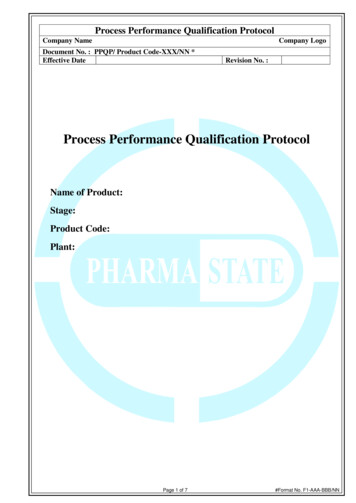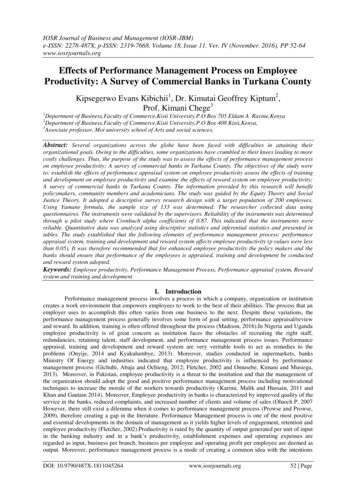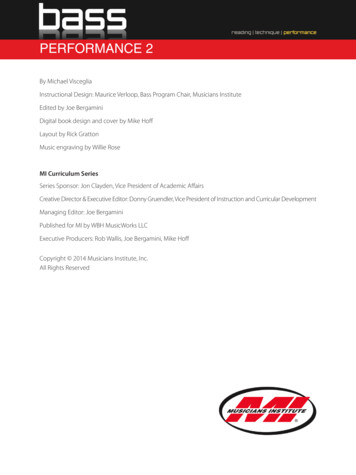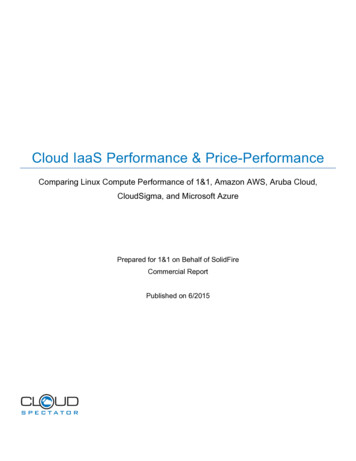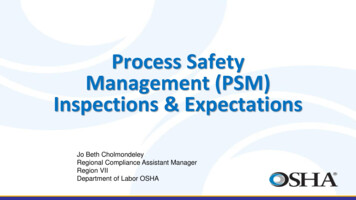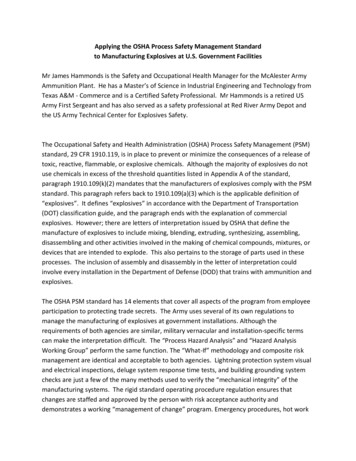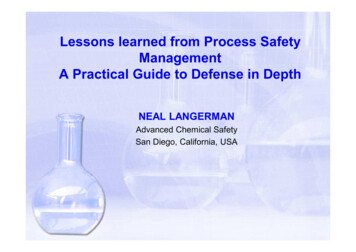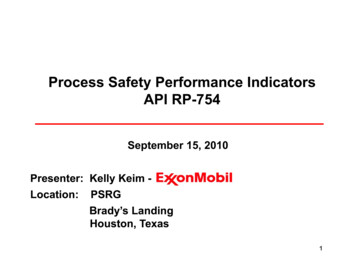
Transcription
Process Safety Performance IndicatorsAPI RP-754September 15, 2010Presenter: Kelly Keim Location: PSRGBrady’s LandingHouston TexasHouston,1
Outline CSB Recommendation RP-754 Development– CommitteeCiMMembershipb hi– Scope & Applicability– Guidingg Principlesp RP-754 Process Safety Indicators– Tier 1, 2, 3 & 4– Guidelines for Selection & Use of Indicators RP-754 Process Safety Indicator Reporting– BroadB dAAccess (N(Nationwide)tiid ) PPublicbli RReportingti– Local (Site) Public Reporting– Data Capturep Path Forward / Timeline2
CSB Recommendation to API & USW“Work together to develop two new consensusAmerican National Standards Institute (ANSI)standards. In the first standard, create performanceprocess safetyy in the refineryy andindicators for ppetrochemical industries. Ensure that the standardidentifies leading and lagging indicators fornationwide public reporting as well as indicators foruse at individual facilities. Include methods for theddevelopmentlt andd use off ththe performancefiindicators.”di t”3
Total Recordable Incident Rate vs. Calendar Year – U.S. RefineriesExpectation that RP-754 will aidin driving similar improvementsin process safety performance4
RP 754 – Committee Membership Academia (1) – MKO Process Safety Center –––––––––––Associations ((5))– ACC– CCPS– NPRA– UKPIA ORC Engineering & Construction (1)– UOP Government (1) CSB Labor (3)(Withdrew 04-Aug-09)– USW– ICWUC– TeamstersOwner/Operators – Refiners (11) BPChevronCHS Inc.Chevron PhillipsKochoc Ind.dPasadena r/Operator – Chemicals (2)– DuPont– Dow Air Products Observer5
RP-754 Guiding Principles Starting Point – Capitalize on Previous Work– API / ACC / CCPS loss of primary containment definition– API other loss of primary containment definition– UK HSE and CCPS guidelines for process safety metrics6
RP-754 Guiding Principles Key Concepts – Indicator Attributes / Principles– Objective,jfew and simplep– Well defined, capable of being applied consistently across theindustry– IIndicatorsdi tshouldh ld ddrivei process safetyf t performancefiimprovementtand learning.– Indicators useful to all stakeholders and allow internal and externalbenchmarking– Indicators should be statistically valid, provide appropriate sensitivityto be useful for continuous improvement; sufficient # of events toallow predictive monitoring and identification of performance trends.7
Process Safety Indicator Pyramid ingggLaTier 1LOPC Events ofGreater ConsequencestoricaIndBroadB ublicReportingReportingTier 2 Tiers 1 & 2 are RP754 standardizedd fi i idefinitionsTiers 3 & 4 arecompanyp y definedperformanceindicatorsLOPC Events ofLesser ConsequencestoricaIndCh llChallengestot SafetyS f t SystemsS tingadLeTier 3Tier 4Operating Discipline & Management SystemPerformance Indicators8
RP-754 Applicability RP-754 Applicability– Developed for the refining and petrochemical industries, butmay also be applicable to other industries where loss ofcontainment has the potential to cause harm.– “ProcessProcess Safety”Safety as used in the document is independent ofand broader than OSHA regulatory requirements.– Applicabilitypp cab ty notot limitedted to facilitiesac t es cocoverede ed by OSOSHA PSMS oorsimilar national or international regulations.– Exclusions to focus metrics on Process Safety vs. all otherareas.9
Applicability / Events Excluded from Process Safety ReportingApplicability is not limited to those facilities covered by the OSHA ProcessSafety Management Standard , 29 CFR 1910.119 or similar national andinternational regulations.Events associated with the following activities fall outside the scope of thisRP:a)b)c)d)e)f)Releases from pipeline transfer operations occurring outside the processor storage facility fence line;Marine transport operations, except when the vessel is connected to theprocess for the purposes of feedstock or product transfer;Truck or rail operations, except when the vessel is connected to theprocess for the purposes of feedstock or product transfer, or if the truck orrail car is being used for on site storage;Vacuum truck operations, except on-site truck loading or dischargingoperations, or use of the vacuum truck transfer pump;Routine emissions that are allowable under permit or regulation;Office, shop and warehouse building events (e.g. office fires, spills,personnel injury or illness, etc.)10
Applicability / Events Excluded from Process Safety ReportingEvents associated with the following activities fall outside the scope of thisRP:g)h)i)j)k)Personal safety events (e.g.(e g slips,slips trips,trips falls) that are not directlyassociated with on-site response to a loss of primary containment (LOPC)event;LOPC events from ancillary equipment not connected to the process (e(e.g.gsmall sample containers);Quality assurance (QA), quality control (QC) and research anddevelopment (R&D) laboratories (pilot plants are within RP scope);Retail service stations; andOn-site fueling operations of mobile and stationary equipment (e.g. pickup truckstrucks, diesel generatorsgenerators, and heavy equipment)equipment).11
p2Tier 1 -- Process Safety Event Tier 1 – An unplanned or uncontrolled release of any material, includingnon-toxic and non-flammable materials (e.g., steam, hot condensate,nitrogen, compressed CO2 or compressed air) from a process thatresults in one or more of the consequences listed below:– An employee,employee contractor or subcontractor “daysdays away from work”workinjury and/or fatality; or– A hospital admission and/or fatality of a third party; or– An officially declared community evacuation or shelter-in-place ; or– A fire or explosionpresultingg in ggreater than or equalqto 25,000,ofdirect cost to the Company; or .12
Slide 12p2I would keep these Tier 1 and 2 slides but would also use the Annex C Decision Logic Tree as part of the webinar in some fashion. Itemphasizes the thought process you must go through to classify an event as a PSE.paulkkl, 2/22/2010
p3Tier 1 -- Process Safety Event – Cont’d– A pressure relief device (PRD) discharge to atmosphere whetherdirectly or via a downstream destructive device that results in one ormore of the following four consequences: Liquid carryover, or Discharge to a potentially unsafe locationlocation, or On-site shelter-in-place, or Public pprotective measures ((e.g.,g road closure);)where the PRD discharge quantity is greater than the thresholdquantities in Table 1; or– A release of material greater than the threshold quantities describedin Table 1 in any one-hour period. Ti 1 PSE RateTierR t (Total(T t l TierTi 1 PSE Count/TotalCt/T t l WWorkkHHours)) x200,00013
Slide 13p3I would keep these Tier 1 and 2 slides but would also use the Annex C Decision Logic Tree as part of the webinar in some fashion. Itemphasizes the thought process you must go through to classify an event as a PSE.paulkkl, 2/22/2010
Tier 1 Material Release Threshold QuantityThresholdR lReleaseCategoryMaterial HazardClClassificationifi ytit(indoors)1TIH Hazard Zone AMaterials5 kg(11 lbs)2.5 kg(5.5 lbs)2TIH Hazard Zone BMaterials25 kg(55 lbs)12.5 kg(27.5 lbs)3TIH Hazard Zone CMaterials100 kg(220 lbs)50 kg(110 lbs)4TIH Hazard Zone DMaterials200 kg(440 lbs)100 kg(220 lbs)14
Tier 1 Material Release Threshold QuantityThresholdReleaseCategoryMaterial esholdQuantity(indoors)5Flammable Gases or Liquids withIBP 35 C & FP 23 C, orOther Packing Group I Materialsexcluding strong acids/bases500 kg(1100 lbs)250 kg(550 lbs)6Liquids with IBP 35 C andFlash Point 23 C,C, orOther Packing Group II Materials1000 kg(2200 lbs)or7 bbls500 kg(1100 lbs)or3.5 bbls7Liquids with FP 23 C and 60 C, or Liquids with Flash Point 60 C released at or above FP,, orStrong acids/bases, orOther Packing Group III Materials2000 kg(4400 lbs)or14 bbls1000 kg (2200lbs)or7 bbls15
Materials Typical of Threshold Release CategoriesThe following are UN DGL & GHS designations for FlammableLiquids & GasesFlammable Gases and Liquidsqwith IBP 35oCHydrogen, Methane, Ethane, LPG, Ethylene, isopentaneFlammable Liquids with IBP 35oC and FP 23oCN-pentane, cyclopentane, hexane, cyclohexane, gasoline / petrol, toluene,o-xylene (but not meta or para-xylene), MTBE, ethanol, some crude oilsFlFlammablebl LiquidsLi id withith FP 23oC andd 60oCDiesel fuel, most kerosenes, p-xylene, n-butanol, isobutanol, some crudeoilsFlammable Liquids with FP 60oC (Must be released above FlashPoint for Tier 1)Mostt asphalts,Mh lt tars,tmoltenlt sulfurlf (160oC),C) ethyleneth lglycolll (110oC),C)propylene glycol (99oC)16
Materials Typical of Threshold Release CategoriesTIH – Toxic Inhalation Hazard & ZonesTIH – Zone A: Br, HCN, Nickel Carbonyl, Phosgene, Methyl Isocyanate (MIC)TIH – ZoneZB:B BBoron TTrifluorideiflid (BF3),) Chlorine,Chl iH2S,S RedR dFFumingiNitricNit i AcidA idTIH – Zone C: Hydrogen Chloride (HCl), Hydrogen Fluoride (HF), SulfurDioxide (SO2)TIH – Zone D: Ammonia (NH3), Carbon Monoxide (CO), Ethylene OxideOther hazardous materials are assigned to a Packing Group (I(I, IIII, or III)depending upon level of hazard.PG I: Aluminum Alkyls, Some Liquid Amines, Sodium Cyanide, SodiumPeroxidePG II: Aluminum Chloride, Calcium Carbide, Carbon Tetrachloride, Nicotine,Some Organic Peroxides, PhenolPG III: Calcium Oxide (CaO), Activated Carbon, Chloroform, Some Organic17Peroxides, Sodium Fluoride, Sodium Nitrate, Sulfur
Tier 2 -- Process Safety Event Tier 2 -- An unplanned or uncontrolled release of any material,including non-toxic and non-flammables materials (e.g., steam,hot condensate, nitrogen, compressed CO2 or compressed air)from a process which results in one or more of theconsequences listed below and is not reported in Tier 1:– An employee, contractor or subcontractor recordable injury; or– A fire or explosion resulting in greater than or equal to 2,500of direct cost to the Company; or18
Tier 2 -- Process Safety Event– A pressure relief device (PRD) discharge to atmosphere whetherdirectly or via a downstream destructive device that results in one ormore of the following four consequences: Liquid carryover, or Dischargeg to a ppotentiallyy unsafe location, or On-site shelter-in-place, or Public protective measures (e.g., road closure);where the PRD discharge quantity is greater than the thresholdquantities in Table 2; or– A releaseloff materialt i l greatert ththan ththe ththresholdh ld quantitiestiti ddescribedib din Table 2 in any one-hour period. Tier 2 PSE Rate ((Total Tier 2 PSE Count/Total Work Hours)) x200,00019
Tier 2 Material Release Threshold QuantityThresholdReleaseCategoryMaterial Hazard Quantity(indoors)1TIH Hazard Zone A Materials0.5 kg(1.1 lbs)0.25 kg(.55 lbs)2TIH Hazard Zone B Materials2.5 kg(5 5 lb(5.5lbs))1.2 kg(2 8 lb(2.8lbs))3TIH Hazard Zone C Materials10 kg(22 lbs)5 kg(11 lbs)4TIH Hazard Zone D Materials20 kg(44 lbs)10 kg(22 lbs)20
Tier 2 Material Release Threshold QuantityThresholdReleaseCategoryMaterial Hazard Quantity(indoors)5Flammable Gases or Liquidswith IBP 35 C and FP 23 C ; orOther Packing Group IMaterials50 kg(100 lbs)25 kg(50 lbs)6Liquids with FP 23 C and 60 CC or Liquids with FP 60 C released at or above FP; orOther Packing Group II and IIIMaterials excluding moderateacids/bases;or Strong acids and bases100 kg(220 lbs)or1 bbl50 kg(110 lbs)or0.5 bbl7Liquids with FP 60 CreleasedldbbelowlFPFP;or Moderate acids/bases1000 kg(2200 lbs)lb )or10 bbl500 kg(1100 lblbs))or5 bbl 21
Tier 3 & 4 versus Tier 1 & 2Swiss Cheese ModelHAZARDHAZARD Protective “Barriers”“Weaknesses”or holesThe Swiss Cheese Model (Reason,1990) helps to compare and contrast:– Tier 1 events result in some level of harm(fire, LWC, release, etc.)– Tier 2 events result in a lesser level offharm.HARM– Tier 3 and 4 indicators provideinformation about the strength (or lackthereof) of barriers and weaknesses inthe equipment and hazard controlsystems.22
Tier 3 – Challenge to Safety Systems Purpose– Tier 3 indicators are likely to provide the greatest opportunity foridentification of areas for improvement in Process Safety at the site level.– Intended for internal company use and local (site) public reporting.Application of the Barrier concept– Tier 3 indicators typically represent challenges to the barrier system thatprogressed along the path to harm, but were stopped short of a Tier 1 orTier 2 LOPC consequence.Examples– SafeS f OperatingOti LimitLi it EExcursionsi– Primary Containment Inspection or Testing Results Outside AcceptableLimits– Demands on Safety Systems Activation of a Safety Instrumented System Activation of a Mechanical Shutdown System Activation of Pressure Relief Device (not counted as Tier 1 or Tier 2)– Other LOPC Events23
Tier 3 Indicator #1Safe Operating Limit Excursions-This is a process parameter deviation that exceeds the safe operating limitapplicableli bl to theh phasehoff operation.i-Different operating phases (startup, ongoing operation, steps in a batchprocess, etc.) may have different SOL’s for the same equipment.-SafeSf OperatingOti LimitsLi it representt theth pointi t beyondbd whichhi h ttroubleshootingbl h tiends and pre-determined action occurs to return the process to a knownsafe state.-Pre determined actions may range from manually executed operatingPre-determinedprocedures to a fully automated safety instrumented system.Example of Safe Operating Limit for Tank Level
Tier 3 Indicator #2Primary Containment Inspection or Testing ResultsOutside Acceptable Limits-This is an inspection or test finding that indicates primary containmentequipment has been operated outside acceptable limits.-Findings typically trigger actions such as replace
15.09.2010 · RP-754 Applicability RP-754 Applicability – Developed for the refining and petrochemical industries, but may also be applicable to other industries where loss of containment has the potential to cause harm. – “Process SafetyProcess Safety” as used in the document is independent ofas used in the document is independent ofFile Size: 349KBPage Count: 40

